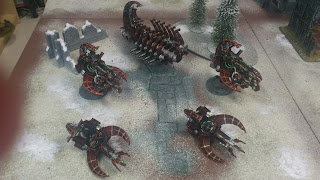Dear readers,
I have to be one of the slowest bloggers in history, but this is just something you're going to have to forgive me for - for the time being at least. Exams are coming up so a lot of my time is having to go into this crazy thing called 'studying'... Nevertheless, the fact that I have to revise means that procrastination is inevitable, and that procrastination has been put to some use!
So I'd been hearing good things about wet palettes for a while now. Since involving myself more in the miniature-painting community online I've found out more and more about the benefits that accompany painting from a wet palette. Previously I had always been quite happy with my old kitchen tile found somewhere in the deepest, darkest corners of our garage, but now that my eyes have been opened I don't think there's any reason I would go back.
Here's how:
1) Collect the necessary items. You'll need:
- A plastic box of a good size. The one I used is not very deep and this is certainly a benefit.
- Some thin, but large, absorbent sponges. These are the ones typically used for household cleaning. I found mine in Tesco for £1.20.
- Baking paper. I have heard parchment is suitable too, but not as cheap or easily available. This 8 metre roll was only £1.25.
- Scissors. They don't have to be bright blue, but it certainly helps.
2) Cut the sponge so that it fits neatly into the bottom of your plastic box. I'm not going to patronise you by telling you to be careful with scissors... I mean, you're only cutting a sponge. You'll need just one layer, so you certainly won't be using your whole £1.20's worth in one go. The sponge doesn't have to fit right up against the edges, but you want to try and fill most of the box.
3) Next, you need to soak the sponge so it contains the maximum amount of water it possibly can. I ran mine under a tap and let it sit in the sink for a little bit. Let most of the excess water drip out and place your sponge(s) in the bottom of your box.
4) Finally, use your scissors again (CAREFUL!!!!11!!one!!) to cut out a bit of baking paper that will fit nicely into the box. Place this on top of the sponge and just pat it down. It should stick to the sponge nicely and will look like it does in this picture. If a lot of water droplets start forming on the surface of your palette then there is too much water under the paper - just squeeze a little water out of your sponges and try again.
5) Apply paint as you would normally. You won't have to add too much water as the moisture will naturally dilute the paint you apply.
So that's it - simple! You only need to take five minutes or so to do this and the results are great. Paint stays wet for a long time, particularly if you seal it with a lid. I left one mixture on there for 24 hours, as a test, and I was still able to use it the next day! As a tip I would suggest not to spread your paint out too much - this will dry it out quicker - but to keep it in little pools on the palette. Give it a go people, it's a great addition to a painter's arsenal.

So the Trollbloods are seeing some paint every time I get sick of revision. Not a great deal has been done but I did spend a while faffing over how to do the tartan. I ended up going for a dark green shade, highlighted using Trollblood Highlight (P3) to give it a 'woolly' look. I figured wool usually isn't so vibrant and it would look strange to highlight it simply using brighter greens. For the base-coat I used Caliban Green - one of the new GW Base Paints - and I was happy with the results; it covered well and produced a strong colour.

Next I used Trollblood Highlight to carefully draw the horizontal white lines across the tartan; later, after painting the red, I went back and highlighted the edges with a thin layer of Skull White.

The red was painted with Sanguine Base (P3) and highlighted with Skorne Red (P3). Where the red lines crossed I carefully painted on squares of a different colour - for this I used Midlund Flesh (again - P3), which was highlighted by adding a bit of white. As you can see, I painted a horizontal red line every other white line, so that it doesn't look too 'busy'. I'm quite happy with the result, but you guys must decide for yourself! The pictures aren't great I'm afraid, I had to borrow a friend's camera because I stupidly left mine at home...

The other four Champions saw some work over the last few days as well. I finished the bronze/gold (I can never decide) on their weapons and gave their skin a base-coat. Since taking the pictures I've also shaded their skin and painted a base-coat on to the Dire Troll Mauler that will be my next project.
Well, that's it for today folks! I hope you find the tutorial useful and that you give the wet palette a go. If you have any comments, criticisms or suggestions I am always happy to read them, so please leave them below. Happy painting!






















